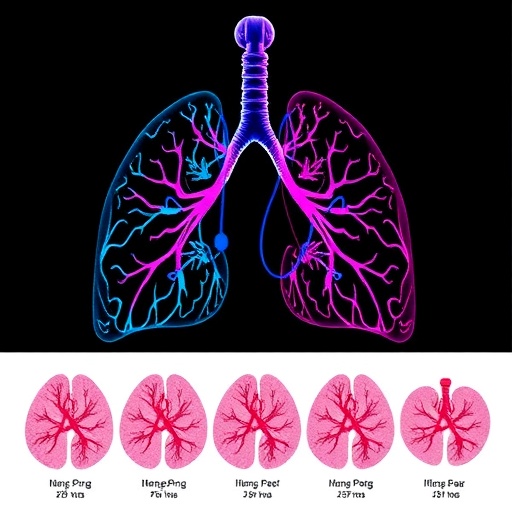In a remarkable stride toward revolutionizing cancer diagnostics, a newly published study in the International Journal of Surgery showcases how the integration of generative artificial intelligence (GenAI) can transform the pathological assessment of lung adenocarcinoma. This deadly form of lung cancer, notorious for its diagnostic complexity, demands meticulous microscopic examination by pathologists — a process traditionally marked by subjectivity and tremendous time investments. Leveraging advanced GenAI models, researchers from Southern Medical University’s Zhujiang Hospital have demonstrated a paradigm shift, where AI not only accelerates diagnosis but also enhances precision to rival, and in some aspects surpass, human expertise.
The study led by Dr. Anqi Lin presents an in-depth evaluation of three state-of-the-art GenAI frameworks: GPT-4o, Claude-3.5-Sonnet, and Gemini-1.5-Pro. These models were trained and tested on an extensive data set comprising 310 diagnostic slides sourced from The Cancer Genome Atlas (TCGA) along with another 182 slides from various independent medical institutions. The focus was particularly on the ability of these AI systems to identify subtle pathological cancer patterns and accurately grade tumors, an endeavor generally fraught with interpretative variability among human experts. Remarkably, the results revealed that GenAI could achieve consistent, reproducible accuracy levels, signaling a breakthrough for digital pathology.
Among the trio, Claude-3.5-Sonnet surfaced as a frontrunner, reaching an average accuracy of 82.3% in differentiating cancer grades. Notably, its performance remained steadfast across repeated trials on identical slide sets, a significant measure of reliability in clinical contexts. This consistency addresses a critical hurdle in conventional pathology, where inter-observer variability poses persistent challenges, often affecting treatment decisions and patient prognoses. By providing uniform assessments, this GenAI model offers an indispensable tool for standardizing cancer grading at scale.
Yet, the implications of this work extend far beyond grading. The researchers engineered a prognostic model that synthesizes GenAI-extracted pathological features with patients’ clinical data, enabling predictive insights into disease progression and survival outcomes. This hybrid model encapsulates 11 distinct histological characteristics alongside 4 crucial clinical variables, collectively rendering a robust, mathematically grounded risk stratification framework. Such an integrative approach harnesses the strengths of AI and clinical medicine synergistically, potentially transforming personalized patient management.
One transformative advantage detailed in the study is the AI system’s efficiency in quantifying histological attributes such as tumor necrosis, cellular architecture, and inflammatory infiltrates with exact numerical percentages. This contrasts starkly with the traditional qualitative or semi-quantitative descriptions typically employed by pathologists. The transition from subjective observation to objective measurement not only streamlines workflows but also facilitates precise monitoring of disease progression or treatment response over time — a leap forward for evidence-based oncology.
The research team highlights the enormous potential of GenAI-assisted pathology especially in resource-limited settings. Global disparities in access to experienced pathologists frequently hinder timely diagnosis and treatment plans, magnifying cancer mortality in underserved regions. Deploying GenAI models capable of delivering high-fidelity diagnostic support on digital slide imagery could democratize access to expert-level pathology consultation worldwide, overcoming geographical and infrastructural barriers that impede cancer care equity.
Furthermore, the adoption of GenAI can significantly mitigate the long-standing problem of inter-observer variability. The study underscores how even leading pathologists can differ considerably when evaluating nuanced histological patterns, leading to inconsistent diagnoses. In contrast, AI-powered evaluations maintain unwavering consistency, reinforcing clinical confidence and reproducibility. This feature is particularly vital when assessing complex tumor heterogeneity or subtle morphological distinctions that influence grade assignment and prognosis.
Delving into the broader scientific implications, the AI models demonstrated the capability to concurrently analyze multiple histological features, uncovering prognostic factors previously underappreciated or overlooked. Among these, interstitial fibrosis, papillary pattern formations, and lymphocytic infiltration stood out as the most significant variables correlated with patient outcomes. The systematic, high-throughput quantification of such features, typically impractical via manual methods, paves the way for novel biomarker discovery and a deeper pathobiological understanding of lung adenocarcinoma.
This integrative GenAI methodology thus not only improves diagnostic accuracy and prognostication but also holds the promise to reshape therapeutic strategies. By elucidating intricate pathological signatures linked to disease aggressiveness and treatment response, clinicians could tailor interventions more precisely, advancing the frontier of personalized oncology. The capability to extract explainable features ensures that AI outputs remain interpretable, fostering trust and facilitating seamless integration into clinical workflows.
The study also addresses the technological robustness of the GenAI architectures used. Each model incorporates sophisticated natural language processing and image analysis techniques, enabling them to interpret complex tissue morphology from digital pathology slides. This dual capability underscores the evolving role of AI as a bridge between visual medical data and clinical reasoning, augmenting human intellect with computational power. The deployment of these models in real-world settings will require ongoing optimization and validation, but the foundational success reported here provides a strong impetus for rapid clinical adoption.
Importantly, the research team emphasizes ethical transparency and the absence of conflicts of interest, underscoring a commitment to unbiased scientific inquiry. Their pioneering work exemplifies how open collaboration between medical experts and AI technologists can generate impactful solutions without commercial bias, an essential factor in maintaining integrity as AI becomes increasingly entrenched in healthcare.
In summary, this landmark investigation heralds a new era where generative artificial intelligence empowers pathologists by enhancing diagnostic precision, reducing workload, and enabling comprehensive prognostic insights in lung adenocarcinoma. By harnessing the synergy of AI and clinical expertise, the study not only advances cancer diagnostics but also lays the groundwork for more equitable, consistent, and data-driven cancer care worldwide. As these GenAI models continue to mature and integrate seamlessly with medical practices, they promise to redefine standards, delivering faster, smarter, and more personalized oncology diagnostics on a global scale.
Subject of Research: People
Article Title: Evaluating generative AI models for explainable pathological feature extraction in lung adenocarcinoma: grading assessment and prognostic model construction
Web References:
http://dx.doi.org/10.1097/JS9.0000000000002507
Image Credits: Junyi Shen et al.
Keywords: Cancer, Internal medicine




